 Browns Archive
Browns Archive  Browns Game Vault: 10/23/89. HC Bud Carson’s Glorious MNF Triumph
Browns Game Vault: 10/23/89. HC Bud Carson’s Glorious MNF Triumph
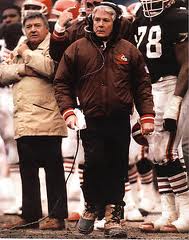
Coach Marty Schottenheimer was gone. It was a great run, but by now, many of the local fans and media had had enough. And since Cleveland Browns owner Art Modell tended to base public decisions on public opinion, Marty had to go.
To some extent, it was the coach’s fault.
After the 1987 season, he’d suffered the misfortune of losing offensive coordinator Lindy Infante, who’d moved on to become head coach of the Green Bay Packers. Infante was an innovative offensive mind who’d been the head coach of a USFL team through the 1985 season. When that league folded, the Browns famously scooped up several players who fortified their late 1980s run. But the fact that Infante was also a USFL refugee is perhaps overlooked.
(The Infante offense shares a common approach with the West Coast Offense (dubbed as such by Bernie Kosar): the reliance upon the quarterback to read and react to a defense, rather than run predetermined plays regardless of defensive alignment or shifts. While Bill Walsh’s WCO expected the quarterback to make presnap reads, Infante asked both the quarterback and the receivers to make reads, both pre- and post-snap. His offense was also more ‘vertical’ than the quick-timing WCO.)
The offense Infante brought to the Browns was a nice fit for the cerebral Bernie Kosar, who also had the weapons to throw to in Webster Slaughter, Ozzie Newsome, Reggie Langhorne and Brian Brennan. And when the offensive coordinator moved on the Green Bay, Schottenheimer decided he would run the offense himself.
On one level, that made a lot of sense. The Browns were still solid playoff contenders, and this was no time for an offensive overhaul. Coach Marty’s veteran group would use the same system, same terminology. It seemed to work well enough, for a while, depending on whom you listened to at the time. But you knew that having a defensive specialist taking over a high-octane offense would attract scrutiny, and therefore blame, at some point.
1988 had ended badly, in the Browns’ context as a Super Bowl contender. The 10-6 Browns were illustrating the perils of a front office committing offensive line neglect: their quarterbacks kept getting hurt. After Kosar went down, so did Gary Danielson, and eventually Don Strock. The regular season ended with the Browns defeating the Houston Oilers at home, earning a Wild Card rematch at the stadium the very next week.
The playoff game was extremely frustrating. Jerry Glanville’s proudly thuggish Oilers baited the Browns into several horrible penalties; Coach Marty suffered from very bland play calling in the red zone; the referees had a bad day. QB Mike Pagel engineered a late scoring drive to make it a one-possession game, and we home fans held out some anguished hope as the Browns’ try for an onside kick was attempted three times due to the Oilers illegally batting the ball out of bounds, and then the ball trickling out of bounds before it was touched. We sat and eyed each other as the third try was recovered by the Browns- but the ruling was that they touched the ball before it advanced 10 yards.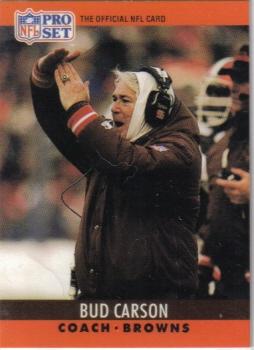
The playoff loss was due in large part to a collapse by the defense in the playoffs for the fourth straight year. But the lightning rod was the offense. Amid local unrest, Art Modell issued an ultimatum: the Cleveland Browns needed to have an offensive coordinator. Three days after the playoff loss to the Oilers, he issued a public statement that included the terms “irreconcilable differences”, “amicable parting”, “philosophies, particularly…offensive coordinator”. Marty Schottenheimer was out.
The man chosen to take the reins and continue this era of contention was long-time defensive coach, and former Marine, Bud Carson. Much of the credit was given to Carson for the success of the Pittsburgh Steelers in the 1970s (along with the Steelers’ team doctor- allegedly). Carson was chosen as part of the Browns’ overriding goal of getting past the Broncos’ John Elway in the playoffs. He was not given a say in player acquisition, and his offensive coordinator had been pre-selected for him: Marc Trestman, former offensive coach of the Vikings and Buccaneers.
During Carson’s brief tenure as Browns head coach, there were some highlights. Fans still talk about the 51-0 drubbing inflicted upon the Steelers, in Carson’s debut. And there was a midseason victory over the Broncos at the stadium- a game in which Carson constantly was sending disguised blitzes at Elway, in direct contrast to the “Martyball” style of reacting instead of dictating the action.
My favorite example was the Monday night home game against the contending Chicago Bears.
The 3-3 Browns’ season was choppy, to this point. As the national media arrived and figuratively trained their spotlight on Cleveland, the local heroes entered the game on a two game losing streak. Mike Ditka’s 4-2 Bears sat atop the NFC Central Division, and still had a lot of national credibility from their Super Bowl XX victory. They were the number one scoring team in the NFL. It was a matchup of The Frig, Willliam Perry, vs. his less-celebrated yet more talent brother, Browns defensive lineman Michael Dean Perry.
Bernie Kosar was the star of this game (22 of 29 for 281 yards), which boasted several highlights.
- ·Kosar hit RB Eric Metcalf with a 30yard touchdown pass.
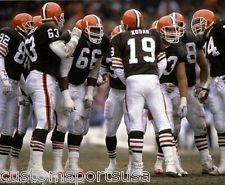
- ·The Browns recorded three sacks of Bears quarterbacks Jim Harbaugh and Mike Tomczak.
- ·CB Frank Minnifield picked off a Tomczak pass.
- ·With a nice lead late in the third quarter, the Browns defense kept the Bears out of the end zone on 4th and goal at the 2.
On the following play, prior to the snap from the Browns’ own 2, Kosar shot a look to Slaughter. His star wideout raised a fist to his quarterback, which was code for: “Hey, Bernie, I know we are backed up deep in our own end of the field. But we have been burning rookie Lorenzo Lynch all night. Now they have Vestee Jackson over me, in man-to-man coverage. I’m going deep. Get me the ball.” (It’s true.)
My soon-to-be wife and I were standing among the 73,000, with hundreds of others along the south side of the stadium behind the lower level of stands. When Kosar dropped back, Slaughter sprinted down the left sideline. Kosar lofted the ball, which was caught at around the 40. With Jackson in pursuit, the entire crowd rose to its feet as Slaughter appeared to be taking the ball to the house. Jackson closed the gap, and lunged at Slaughter at about the 15. Slaughter spun in a pirouette, tightroped the sideline the rest of the way, and trotted to the Dawg Pound as the deafening electricity arced through the stadium.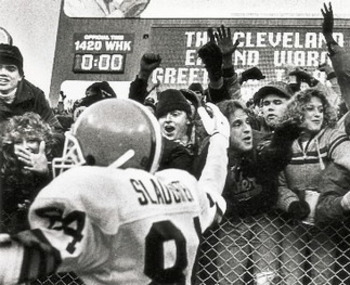
The magic was back. The Browns’ hopes for playoff contention were revived.
After the game, we joined the throng hanging around outside the team exit. Several players were mingling with pockets of fans. Here came ‘Web-star’, slowly moving near us. Perfectly coiffed 80s afro mullet intact. It would be silly of me not to talk to him.
“Hey, Mr. Slaughter.” He nodded. I was really surprised that I was taller than he.
(Mr. Slaughter? Mr. Slaughter? Man, Greg, you FROZE. That was really freaking awkward. Ah, forget it- it’s over.)
Almost immediately after, Bud Carson sauntered by. His face held his characteristically stoic expression, until… “Hey Bud! Great game!” In an instant, his face broke into a huge smile. It was a little startling, since I didn’t think I’d ever seen him smile like that before. And, he was even shorter than Slaughter.
The Browns did make the playoffs after the 1989 season. They ended up facing Elway and the Broncos again- only this time, Elway was ready for the blitz. Denver ran up a lead, but the Browns fought back before falling short.
Bud Carson would be let go in the middle of the 1990 season. The 1980s era was now over- the team was needing several upgrades- and they were losing more and more emphatically as the season wore on. Carson did lead the team to another tense Monday night victory – over Denver- before being fired a few weeks later. He acknowledged he was more effective as a teacher than as a communicator, which he noted is an important skill for a head coach to have. He also lamented his distaste for office politics (which was especially necessary with the Cleveland Browns franchise in those days).
He was an honest man, who spoke the truth.
Thank you for reading. Sources included Tales from the Browns Sideline, Grossi; Wikipedia; pro-football-reference.com; SI Vault; Plain Dealer reporter Tony Grossi’s game story; AP articles.
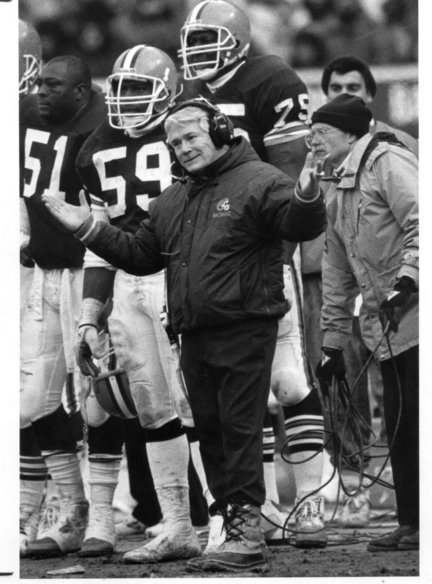
- NBA Announces 2013-2014 Schedule
- Browns Ink Sharknado
- Sharknado A No-Show For Rookie Camp
- Trent Richardson Out Until Training Camp
- Browns Sign Brandon Jackson
- Carrasco Suspended Eight Games
- Browns Add to Wide Receiver Depth with David Nelson
- Browns Need to Learn from Past Draft Mistakes
- Browns Release Chris Gocong and Usama Young
- Browns Missing on Grimes Disappointing, But Not The End
The TCF Forums
- Official- Browns Coach Search/Rumors
mattvan1 (Tuesday, January 21 2014 1:19 PM) - Movies coming out
rebelwithoutaclue (Tuesday, January 21 2014 12:56 PM) - 2015 Recruiting
jclvd_23 (Tuesday, January 21 2014 12:38 PM) - The 2014 Offseason Thread
Larvell Blanks (Tuesday, January 21 2014 12:25 PM) - Chris Grant's first 3 drafts
Kingpin74 (Tuesday, January 21 2014 10:13 AM) - Mike Brown
YahooFanChicago (Monday, January 20 2014 11:15 PM) - 2014 Hoops Hockey Hijinx
jpd1224 (Monday, January 20 2014 4:44 PM) - 2014 Recruiting
jclvd_23 (Monday, January 20 2014 2:26 PM) - Wish List - #4 Pick
Hikohadon (Monday, January 20 2014 1:26 PM) - #1 overall pick Anthony Bennett
TouchEmAllTime (Sunday, January 19 2014 1:28 PM)


